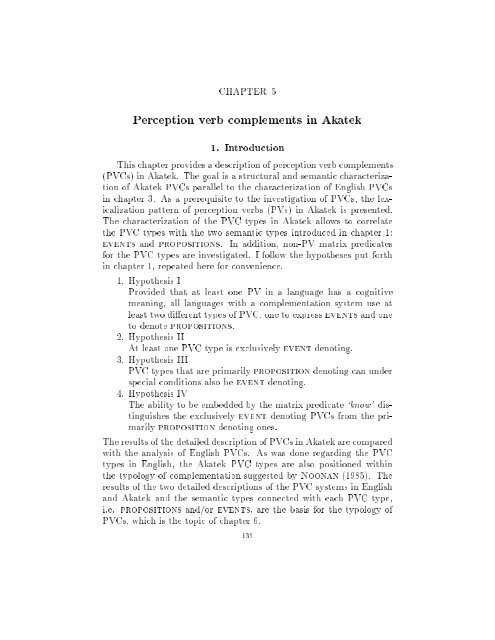Perception verb complements in Akatek, a Mayan language
Perception verb complements in Akatek, a Mayan language
Perception verb complements in Akatek, a Mayan language
Create successful ePaper yourself
Turn your PDF publications into a flip-book with our unique Google optimized e-Paper software.
CHAPTER 5<br />
<strong>Perception</strong> <strong>verb</strong> <strong>complements</strong> <strong>in</strong> <strong>Akatek</strong><br />
1. Introduction<br />
This chapter provides a description of perception <strong>verb</strong> <strong>complements</strong><br />
(PVCs) <strong>in</strong> <strong>Akatek</strong>. The goal is a structural and semantic characterization<br />
of <strong>Akatek</strong> PVCs parallel to the characterization of English PVCs<br />
<strong>in</strong> chapter 3. As a prerequisite to the <strong>in</strong>vestigation of PVCs, the lexicalization<br />
pattern of perception <strong>verb</strong>s (PVs) <strong>in</strong> <strong>Akatek</strong> is presented.<br />
The characterization of the PVC types <strong>in</strong> <strong>Akatek</strong> allows to correlate<br />
the PVC types with the two semantic types <strong>in</strong>troduced <strong>in</strong> chapter 1:<br />
events and propositions. In addition, non-PV matrix predicates<br />
for the PVC types are <strong>in</strong>vestigated. I follow the hypotheses put forth<br />
<strong>in</strong> chapter 1, repeated here for convenience.<br />
1. Hypothesis I<br />
Provided that at least one PV <strong>in</strong> a <strong>language</strong> has a cognitive<br />
mean<strong>in</strong>g, all <strong>language</strong>s with a complementation system use at<br />
least two di erent types of PVC, one to express events and one<br />
to denote propositions.<br />
2. Hypothesis II<br />
At least one PVC type is exclusively event denot<strong>in</strong>g.<br />
3. Hypothesis III<br />
PVC types that are primarily proposition denot<strong>in</strong>g can under<br />
special conditions also be event denot<strong>in</strong>g.<br />
4. Hypothesis IV<br />
The ability tobeembedded by the matrix predicate `know' dist<strong>in</strong>guishes<br />
the exclusively event denot<strong>in</strong>g PVCs from the primarily<br />
proposition denot<strong>in</strong>g ones.<br />
The results of the detailed description of PVCs <strong>in</strong> <strong>Akatek</strong> are compared<br />
with the analysis of English PVCs. As was done regard<strong>in</strong>g the PVC<br />
types <strong>in</strong> English, the <strong>Akatek</strong> PVC types are also positioned with<strong>in</strong><br />
the typology of complementation suggested by Noonan (1985). The<br />
results of the two detailed descriptions of the PVC systems <strong>in</strong> English<br />
and <strong>Akatek</strong> and the semantic types connected with each PVCtype,<br />
i.e. propositions and/or events, are the basis for the typology of<br />
PVCs, which is the topic of chapter 6.<br />
135

















